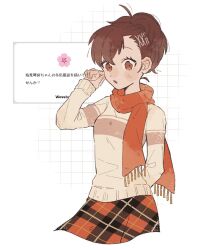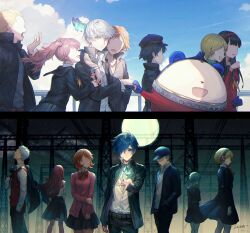Now Viewing: persona_3Tag type: Copyright Tag refers to images referencing this installment of the Persona franchise. It was originally released on July 13, 2006 for the Playstation 2. It marked a significant change for the franchise to the point that the Persona franchise can be divided into pre Persona 3 games and post Persona 3 games. Instead of a straight urban fantasy dungeon crawling JRPG, it fused dungeon crawling gameplay with social sim elements. It was handled by a different crew than past games, this installment was directed by Hashino Katsura with character designs now handled by Soejima_Shigenori and had a hip hop/R&B soundtrack composed by Meguro Shoji. These three men had had prior experience working on the Shin Megami Tensei and Persona franchises, but they had smaller roles in past games. Now, they were at the forefront and the three of them would work together on the next few Persona games which followed the gameplay style established by this game. The vocal songs were performed by Kawamura Yumi and the rap vocals were performed by Lotus Juice. For the latter, this game was his breakthrough, and he went on to perform hip hop songs for many subsequent video games and anime. The songs are all performed in English except for the end credits song, a trend that subsequent Persona games would follow. The story was written by Tanaka Yuichiro, and was a standalone story that was loosely connected to the previous Persona games, although the game does have stronger links to the next two Persona games. The original Persona/SMT designer Kaneko_Kazuma was still involved in designing the demons even if the human characters were no longer designed by him. It is set in the city of Iwatodai, that is funded by the Kirijou Corporation. It seems to be a regular Japanese city, except for the existence of a Shadow Hour, a period of time that takes place between one day and the next. During the Shadow Hour, everyone is turned into a coffin and is completely ignorant of what happens during this hour. However, some people are able to be cognizant during this hour, but unfortunately for them, this makes them the target of monster that roam during the Shadow Hour, the shadows. The game's protagonist Yuuki Makoto just so happens to be one of the people who can move in the Shadow Hour. He had actually lived in Iwatodai before, but has just come back after ten years. Not only can he move around in the Shadow Hour, but he discovers that he has the ability to summon a being from within himself, called a Persona that can fight off the Shadows. Not long after he manifests this ability, he's recruited into SEES, Specialized Extracurricular Execution Squad, a group of high-schoolers who can also summon Personas, but only Makoto can use more than one. With his newfound companions, Makoto sets out to investigate the Shadow Hour, and uncovers some secrets that can threaten humanity's existence. Like the previous games, the player character is a silent hero who functions as an avatar of the player and the story progresses forward as the heroes battle their way through dungeons. However, the game drops the first person exploration and third person isometric view that the previous games used and is entirely rendered in third person. The game adds the Social Link or Community system, where players can interact with certain other characters, help them out with their problems, or even romance them. There is a practical benefit in doing this because it can give the player access to abilities that can help them in combat. The game makes heavy use of blue in its color palette and thematically revolves around death. The game received generally positive critical reviews upon release. While the previous games had some success, this game's success gave greater exposure to the franchise and the game became a mini-franchise within the Persona and SMT franchises with multiple spinoffs and crossovers. It was followed by an anime sequel called Persona Trinity Soul though the subsequent games don't accept it as canon. The game received multiple rereleases. The first was Persona 3 FES, a director's cut for the game, which adds a new story arc after the original game's ending called The Answer. The second was Persona 3 Portable, which adapted the game to the PSP format, and added the option to play as a female protagonist, who has their own unique social links and can giving the romance the game's male cast. The game received a remake called Persona 3 Reload, which updates the gameplay and aesthetics, taking inspiration from Persona 5's art direction and gameplay. It was released on February 2, 2024. Cast: Main Characters: Yuuki_Makoto Kotone_Shiomi * Persona 3 Portable only Iori_Junpei Takeba_Yukari Sanada_Akihiro Kirijo_Mitsuru Yamagishi_Fuuka Aigis Koromaru Amada_Ken Aragaki_Shinjiro Velvet Room: Elizabeth_(Persona) Igor_(Persona) Theodore_(Persona) Kirijo Group: Kirijo_Takeharu Ikutsuki_Shuji Kirijo_Koutetsu Takeba_Eiichiro Social Links: Tomochika_Kenji Odagiri_Hidetoshi Miyamoto_Kazushi Iwasaki_Rio * Fushimi_Chihiro Hasegawa_Saori * Hiraga_Keisuke Mochizuki_Ryoji Nishiwaki_Yuko Andre_Laurent_Jean_Geraux Suemitsu_Nozomi * Pharos_(Persona) Kitamura_Bunkichi Kitamura_Mitsuko Toriumi_Isako Oohashi_Maiko Tanaka_(Persona) Mutatsu_(Persona) Hayase_Mamoru Kamiki_Akinari Shadows: Nyx The_MAgician The_Hanged_Man The_High_Priestess The_Empress The_Emperor The_Hierophant The_Lovers The_Chariot The_Justice The_HErmit Strega: Sakaki_Takaya Shirato_Jin Yoshino_Chidori Other Supporting: Metis Moriyama_Natsuki Vincent_Brooks * Edogawa Kurosawa_(Persona) Saikawa_Kikuno Erebus_(Persona) Follows: Persona_2 Sequel: Persona_4 Persona_Trinity_Soul Remake: Persona_3_Reload Spinoffs: Persona_3:_Dancing_Moon_Night Persona_Q Persona_Q2 Related: Catherine_(game) Other Wiki Information Last updated: 01/15/24 8:33 AM by jojosstand This entry is not locked and you can edit it as you see fit. |
     
|